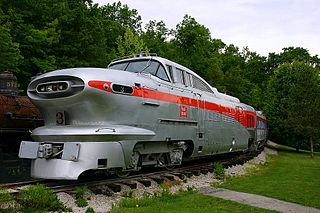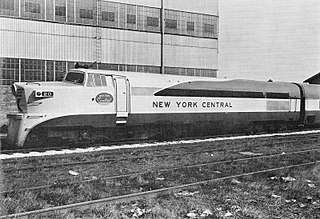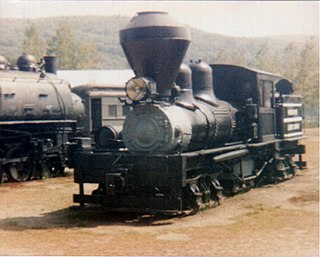Related Research Articles

The New York, New Haven and Hartford Railroad, commonly known as The Consolidated or simply as the New Haven, was a railroad that operated in the New England region of the United States from 1872 to December 31, 1968. Founded by the merger of the New York and New Haven and Hartford and New Haven railroads, the company had near-total dominance of railroad traffic in Southern New England for the first half of the 20th century.

A streamliner is a vehicle incorporating streamlining in a shape providing reduced air resistance. The term is applied to high-speed railway trainsets of the 1930s to 1950s, and to their successor "bullet trains". Less commonly, the term is applied to fully faired upright and recumbent bicycles. As part of the Streamline Moderne trend, the term was applied to passenger cars, trucks, and other types of light-, medium-, or heavy-duty vehicles, but now vehicle streamlining is so prevalent that it is not an outstanding characteristic. In land speed racing, it is a term applied to the long, slender, custom built, high-speed vehicles with enclosed wheels.

Talgo is a Spanish manufacturer of intercity, standard, and high-speed passenger trains.

The St. Lawrence and Atlantic Railroad, known as St-Laurent et Atlantique Quebec in Canada, is a short-line railway operating between Portland, Maine, on the Atlantic Ocean, and Montreal, Quebec, on the St. Lawrence River. It crosses the Canada–US border at Norton, Vermont, and Stanhope, Quebec, and is owned by short-line operator Genesee & Wyoming.

The Flying Yankee was a diesel-electric streamliner built in 1935 for the Maine Central Railroad and the Boston and Maine Railroad by Budd Company and with mechanical and electrical equipment from Electro-Motive Corporation. It was also the name of a passenger train, the third streamliner train in North America. That train ceased passenger service in 1957 and is stored at the Hobo Railroad in New Hampshire and owned by the state of New Hampshire, which plans to open it to public viewing at some time in the future.

The Union Pacific Railroad's M-10002 was a diesel-electric streamliner train built in 1936 by Pullman-Standard, with prime movers from the Winton Engine division of General Motors Corporation and General Electric generator, control equipment and traction motors. It was the UP's third streamliner, and the last turret-cab streamliner.

The Pioneer Zephyr is a diesel-powered trainset built by the Budd Company in 1934 for the Chicago, Burlington & Quincy Railroad (CB&Q), commonly known as the Burlington Route. The trainset was the second internal combustion powered streamliner built for mainline service in the United States, the first such train powered by a diesel engine, and the first to enter revenue service. The trainset consists of one power/storage car, one baggage/RPO/buffet/coach car, and one coach/observation car. The cars are made of stainless steel, permanently articulated together with Jacobs bogies. The construction incorporated recent advances such as shotwelding to join the stainless steel, and unibody construction and articulation to reduce weight. It was the first of nine similarly built trainsets made for Burlington and its technologies were pivotal in the subsequent dieselization of passenger rail service. Its operating economy, speed, and public appeal demonstrated the potential for diesel-electric powered trains to revitalize and restore profitability to passenger rail service that had suffered a catastrophic loss of business with the Great Depression. Originally named the Burlington Zephyr during its demonstration period, it became the Pioneer Zephyr as Burlington expanded its fleet of Zephyr trainsets.

In rail transport, head-end power (HEP), also known as electric train supply (ETS), is the electrical power distribution system on a passenger train. The power source, usually a locomotive at the front or 'head' of a train, provides the electricity used for heating, lighting, electrical and other 'hotel' needs. The maritime equivalent is hotel electric power. A successful attempt by the London, Brighton and South Coast Railway in October 1881 to light the passenger cars on the London to Brighton route heralded the beginning of using electricity to light trains in the world.

The Central Massachusetts Railroad was a railroad in Massachusetts. The eastern terminus of the line was at North Cambridge Junction where it split off from the Middlesex Central Branch of the Boston and Lowell Railroad in North Cambridge and through which it had access to North Station in Boston. From there, the route ran 98.77 miles west through the modern-day towns of Belmont, Waltham, Weston, Wayland, Sudbury, Hudson, Bolton, Berlin, Clinton, West Boylston, Holden, Rutland, Oakham, Barre, New Braintree, Hardwick, Ware, Palmer, Belchertown, Amherst, and Hadley to its western terminal junction at N. O. Tower in Northampton with the Connecticut River Railroad.

Edaville Railroad is a heritage railroad and amusement park in South Carver, Massachusetts, opened in 1947 and continuing to operate as of 2022. It is one of the oldest heritage railroad operations in the United States. It is a 2 ft narrow gauge line that operates excursion trains for tourists, built by the late Ellis D. Atwood on his sprawling cranberry plantation in Southeastern Massachusetts.

The P-12-42, also known as the Speed Merchant, was a streamlined, 1,200 hp (890 kW) locomotive built between 1957–1958 by Fairbanks-Morse, specifically to operate on each end of the Talgo train produced by American Car and Foundry. This model represented F-M's attempted entry into the lightweight locomotive market, but only four of the low-slung units were produced: the first pair was purchased by the New York, New Haven and Hartford Railroad for their John Quincy Adams train, while the second pair went to the Boston and Maine Railroad for their Speed Merchant train.

The EMD LWT12 was a diesel–electric power car that was built in 1955 by General Motors Electro-Motive Division (EMD), to pull a lightweight passenger trainset. The General Motors Company developed both components under the project name, Train Y, but later marketed them as the Aerotrain. Diesel power was provided by an EMD 567C 12-cylinder engine, which produced 1,200 hp (890 kW). Two other GM Diesel engines provided current for train-heating, lighting and air-conditioning.

The UAC TurboTrain was an early high-speed, gas turbine train manufactured by United Aircraft that operated in Canada between 1968 and 1982 and in the United States between 1968 and 1976. Amtrak disposed of the trains in 1980. It was one of the first gas turbine powered trains to enter service for passenger traffic, and was also one of the first tilting trains to enter service in North America.

The Lexington and West Cambridge Railroad was a railroad company chartered in 1845 and opened in 1846 that operated in eastern Massachusetts. It and its successors provided passenger service until 1977 and freight service until 1980 or early 1981.

The RP-210 was a streamlined 1,000 hp (750 kW) locomotive built in 1956 by Baldwin-Lima-Hamilton, specifically to operate with the experimental, all-aluminum Train-X coaches that the Pullman-Standard Car Manufacturing Company built. The model represented Baldwin's attempted entry into the lightweight passenger locomotive market, but only three of the low-slung diesel-hydraulic units were produced. The first was built for the New York Central Railroad to power their Ohio Xplorer train between Cleveland, Columbus, and Cincinnati, and a pair was purchased by the New York, New Haven and Hartford Railroad to double-end their Dan'l Webster, running between New York City and Boston.

The Speed Merchant or Talgo Train was a bi-directional five-car train used by the Boston and Maine Railroad in commuter service between 1958 and 1965 on the road's Eastern and Western routes. Power for the train was from two Fairbanks-Morse P-12-42 diesel-electric locomotives, one at each end of the train, connected by multiple-unit control. Fairbanks-Morse referred to the locomotives as "Speed Merchants" in its promotional literature, but the Boston and Maine never used this moniker. B&M timetables simply called it the "Talgo Train" in advance announcements but, once the train entered service, no names were attached in the printed schedules.
The John Quincy Adams was a named train of the New York, New Haven & Hartford Railroad, between New York, New York and Boston, Massachusetts. The John Quincy Adams was an attempt by the New Haven to modernize rail travel and lure people out of their cars. The train was built by American Car and Foundry to a lightweight Talgo design, and was powered by two Fairbanks-Morse P-12-42 Diesel-electric locomotives, one at each end of the train, connected by multiple unit control.

Steamtown, U.S.A., was a steam locomotive museum that ran steam excursions out of North Walpole, New Hampshire, and Bellows Falls, Vermont, from the 1960s to 1983. The museum was founded by millionaire seafood industrialist F. Nelson Blount. The non-profit Steamtown Foundation took over operations following his death in 1967. Because of Vermont's air quality regulations restricting steam excursions, declining visitor attendance, and disputes over the use of track, some pieces of the collection were relocated to Scranton, Pennsylvania in the mid-1980s and the rest were auctioned off. After the move, Steamtown continued to operate in Scranton but failed to attract the expected 200,000–400,000 visitors. Within two years the tourist attraction was facing bankruptcy, and more pieces of the collection were sold to pay off debt.
Maine Central Railroad began operating diesel locomotives in 1935, and had retired all steam locomotives by 1954. That time interval was a joint operating period with the Boston and Maine Railroad (B&M). This article describes diesel locomotives owned by Maine Central through the period of joint operation and later independent operation prior to Guilford Rail System control in 1981.

Boston and Maine No. 3713, also known as the "Constitution", is the sole survivor of the "P-4a" class 4-6-2 heavy "Pacific" type steam locomotives. It was built by the Lima Locomotive Works for the Boston and Maine Railroad in December 1934. This locomotive is currently being restored to operating condition at the Steamtown National Historic Site in Scranton, Pennsylvania as a part of their operating fleet for use on excursion trains. It is the focus of Project 3713, a partnership between the National Park Service and the Lackawanna & Wyoming Valley Railway Historical Society.
References
- ↑ Jones, Robert Willoughby, BOSTON AND MAINE—City and Shore, Pine Tree Press, Los Angeles CA 1999